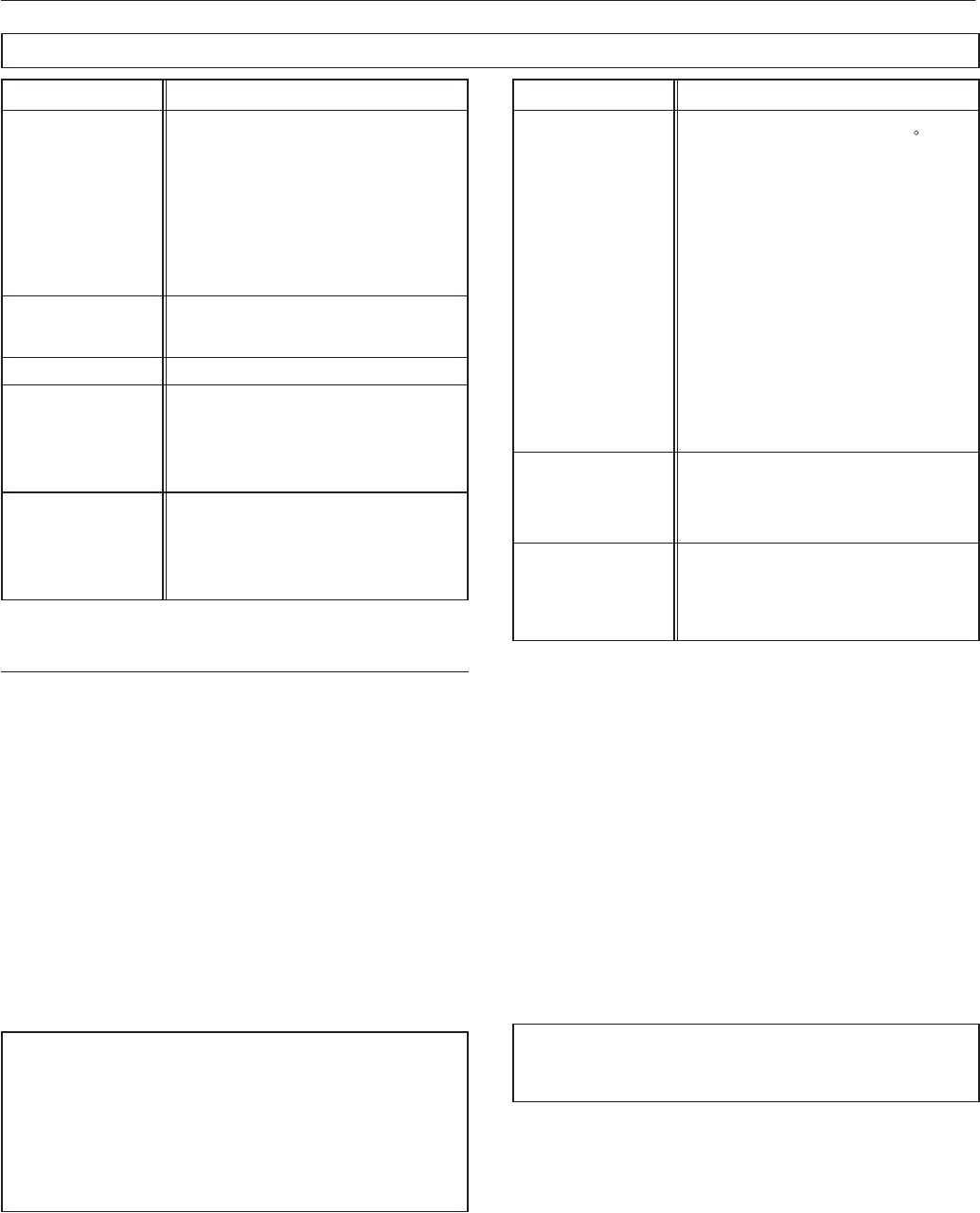
MAINTENANCE
33
enhttp://air.ingersollrand.com
Maintenance Schedule
PERIOD MAINTENANCE
Each 24 hours
operation
Check the coolant level and replenish if
necessary.
Visual check of
machine for any
leaks, dust build up
or unusual noise or
vibration
Report immediately, contact Ingersoll Rand
authorized distributor for assistance if in
doubt
When compressor
is receiver mounted
Drain air receiver of condensate, or check
that automatic drain is operating
Visual check
condition of
package pre −lter
Blow clean if needed
First 150 hours Change the coolant lter.
Each month or 100
hours
Remove and clean package pre −lter,
replace if needed
Check the cooler(s) for build up of foreign
matter. Clean if necessary by blowing out
with air or by pressure washing.
Every 4 months
CONDENSER
Remove any dust from the condenser ns.
COMPRESSOR
Make sure compressor power consumption
complies with data plate specications.
PERIOD MAINTENANCE
Each year or
2000 hours
Check the operation of the high
temperature protection switch (109 C).
Change the coolant lter.
Check scavenge orice for blockage, clean
if required.
Replace elements in IRGP and IRHE
lters.
Change the separator cartridge.
Check motors w/grease ttings - grease
bearings per motor data plate.
Change the Air Filter element.
Take coolant sample for uid analysis.
Change the package pre −lter.
CONDENSATE DRAINS
Completely disassemble the drains and
clean all their components.
Every two years or
8000 hours
Replace the Ultra Coolant at
whichever interval occurs rst.
Check and replace all items included within
2000 hour service
Every 4 years or
16000 hours
Replace sealed bearing without grease ttings
on motors.
18000 hours
Fit replacement electrical contactor tips.
Strip, clean and regrease or replace motor
bearings on motors with grease ttings.
ROUTINE MAINTENANCE
This section refers to the various components which require
periodic maintenance and replacement.
. It should be noted that the intervals between service requirement
may be signicantly reduced as a consequence of poor operating
environment. This would include ef fects of atmospheric contamination
and extremes of temperature.
The SERVICE/MAINTENANCE CHART indicates the various
components’ descriptions and the intervals when maintenance has to
take place. Oil capacities, etc., can be found in the GENERAL
INFORMATION section of this manual.
Compressed air can be dangerous if incorrectly handled. Before
doing any work on the unit, ensure that all pressure is vented from the
system and that the machine cannot be started accidentally.
CAUTION: Before beginning any work on the compressor, open,
lock and tag the main electrical disconnect and close the isolation
valve on the compressor discharge. Vent pressure from the unit
by slowly unscrewing the coolant ll cap one turn. Unscrewing
the ll cap opens a vent hole, drilled in the cap, allowing pressure
to release to atmosphere. Do not remove the ll cap until all
pressure has vented from the unit. Also vent piping by slightly
opening the drain valve. When opening the drain valve or the
coolant ll cap, stand clear of the valve discharge and wear
appropriate eye protection.
Ensure that maintenance personnel are properly trained,
competent and have read the Maintenance Manuals.
Prior to attempting any maintenance work, ensure that: −
. all air pressure is fully discharged and isolated from the system. If
the automatic blowdown valve is used for this purpose, then allow
enough time for it to complete the oper ation.
. the machine cannot be started accidentally or otherwise.
. all residual electrical power sources (mains and battery) are
isolated.
Prior to opening or removing panels or covers to work inside
a machine, ensure that: −
. anyone entering the machine is aware of the reduced level of
protection and the additional hazards, including hot surfaces and
intermittently moving parts.
. the machine cannot be started accidentally or otherwise.
Prior to attempting any maintenance work on a running
machine, ensure that: −
DANGER
Only properly trained and competent persons should
undertake any maintenance tasks with the compressor running or
with electrical power connected.
. the work carried out is limited to only those tasks which require the
machine to run.
. the work carried out with safety protection devices disabled or
removed is limited to only those tasks which require the machine to be
running with safety protection devices disabled or removed.
. all hazards present are known (e.g. pressurised components,
electrically live components, removed panels, covers and guards,
extreme temperatures, inow and outow of air, intermittently moving
parts, safety valve discharge etc.).
. appropriate personal protective equipment is worn.


















